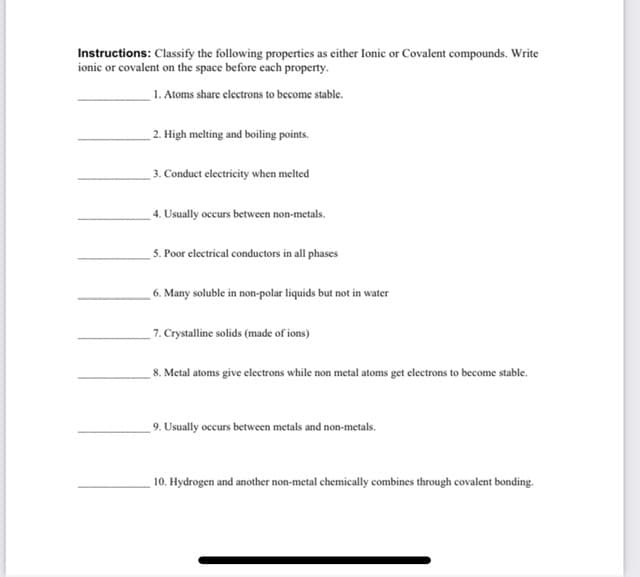Instructions: Classify the following properties as either lonic or Covalent compounds. Write ionic or covalent on the space before cach property. 1. Atoms share electrons to become stable. 2. High melting and boiling points. 3. Conduct electricity when melted 4. Usually occurs between non-metals. S. Poor electrical conductors in all phases 6. Many soluble in non-polar liquids but not in water 7. Crystalline solids (made of ions) 8. Metal atoms give electrons while non metal atoms get electrons to become stable. 9. Usually occurs between metals and non-metals. 10. Hydrogen and another non-metal chemically combines through covalent bonding.
Instructions: Classify the following properties as either lonic or Covalent compounds. Write ionic or covalent on the space before cach property. 1. Atoms share electrons to become stable. 2. High melting and boiling points. 3. Conduct electricity when melted 4. Usually occurs between non-metals. S. Poor electrical conductors in all phases 6. Many soluble in non-polar liquids but not in water 7. Crystalline solids (made of ions) 8. Metal atoms give electrons while non metal atoms get electrons to become stable. 9. Usually occurs between metals and non-metals. 10. Hydrogen and another non-metal chemically combines through covalent bonding.
Chapter3: Mechanisms
Section: Chapter Questions
Problem 15EQ
Related questions
Question
Answwe all questions urgently please !!!!!
filling in the blank spaces

Transcribed Image Text:Instructions: Classify the following properties as either lonic or Covalent compounds. Write
ionic or covalent on the space before cach property.
1. Atoms share electrons to become stable.
_2. High melting and boiling points.
3. Conduct electricity when melted
4. Usually occurs between non-metals.
5. Poor electrical conductors in all phases
6. Many soluble in non-polar liquids but not in water
7. Crystalline solids (made of ions)
8. Metal atoms give electrons while non metal atoms get electrons to become stable.
9. Usually occurs between metals and non-metals.
10. Hydrogen and another non-metal chemically combines through covalent bonding.
Expert Solution
Step 1
The questions given are

Trending now
This is a popular solution!
Step by step
Solved in 4 steps with 1 images

Knowledge Booster
Learn more about
Need a deep-dive on the concept behind this application? Look no further. Learn more about this topic, chemistry and related others by exploring similar questions and additional content below.Recommended textbooks for you


Living By Chemistry: First Edition Textbook
Chemistry
ISBN:
9781559539418
Author:
Angelica Stacy
Publisher:
MAC HIGHER

Organic Chemistry: A Guided Inquiry
Chemistry
ISBN:
9780618974122
Author:
Andrei Straumanis
Publisher:
Cengage Learning


Living By Chemistry: First Edition Textbook
Chemistry
ISBN:
9781559539418
Author:
Angelica Stacy
Publisher:
MAC HIGHER

Organic Chemistry: A Guided Inquiry
Chemistry
ISBN:
9780618974122
Author:
Andrei Straumanis
Publisher:
Cengage Learning

Introductory Chemistry: An Active Learning Approa…
Chemistry
ISBN:
9781305079250
Author:
Mark S. Cracolice, Ed Peters
Publisher:
Cengage Learning

World of Chemistry, 3rd edition
Chemistry
ISBN:
9781133109655
Author:
Steven S. Zumdahl, Susan L. Zumdahl, Donald J. DeCoste
Publisher:
Brooks / Cole / Cengage Learning